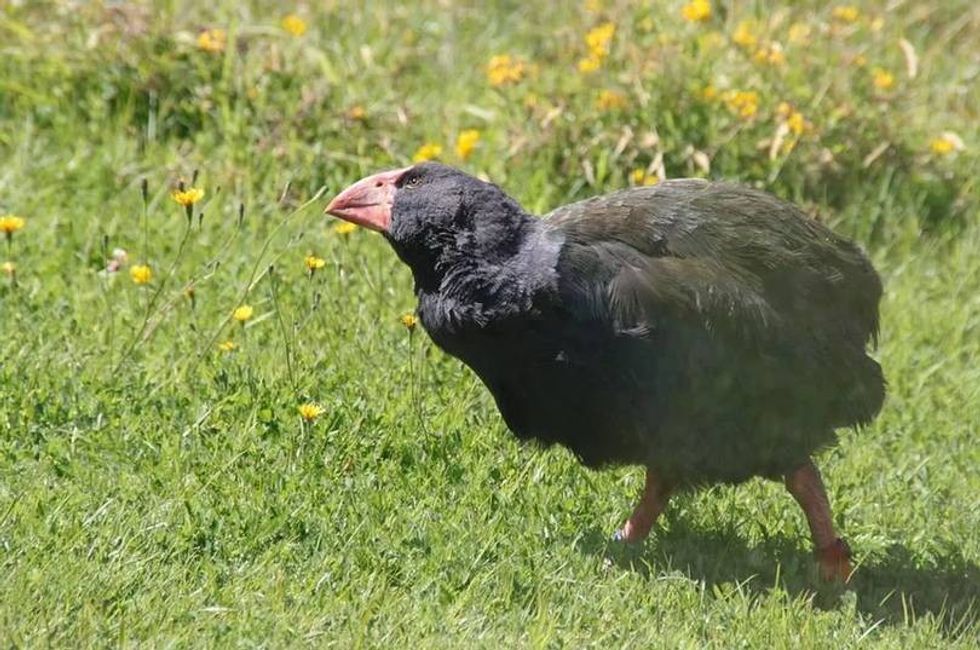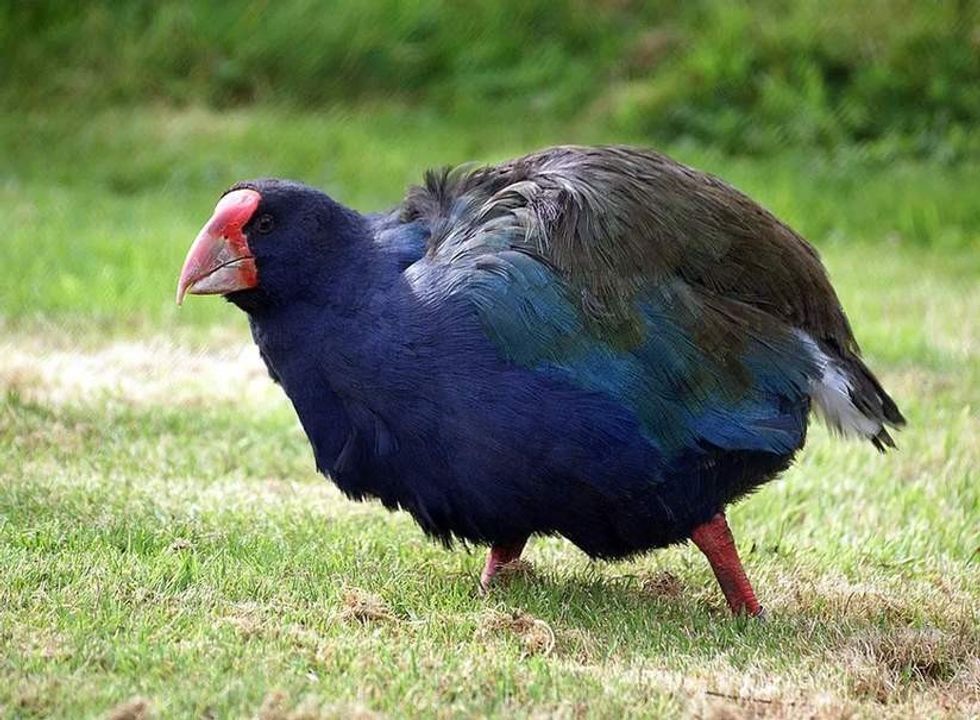The Takahe or Porphyrio hochstetteri is the largest flightless railbird found only in parts of New Zealand and is highly vibrant and beautiful.
Takahe birds were first discovered in 1849. These birds were considered to be extinct in the late 19th century until they were rediscovered in 1948.
After that, they have been protected and conserved under the Takahe Recovery Programme, which ensured that they fall under the species of endangered animals. There are no more than 400 Takahe left in New Zealand.
Due to heavy predators and hunting, they are listed as an Endangered species on the IUCN Red List. They share their habitat with deer and other animals in national parks and sanctuaries in New Zealand and are not aggressive despite being quite fast when they move.
These birds have prominent red legs and a strong red beak. They have shades of olive green, turquoise, and royal blue. Read this article to find out more!
To find out more interesting facts and information about other animals, you can also check our article on the rusty blackbird and Brewer's blackbird for more enriching and mind-blowing facts and guides.
Takahe Interesting Facts
What type of animal is a Takahe?
The Porphyrio hochstetteri or Takahe is a flightless bird that is indigenous to New Zealand and lives in the Murchison Mountains. They belong to rail species and are known to be the largest living rail bird on the North Island.
They are also known as the North Island Takahe or New Zealand Takahe, belonging to the Notornis mantelli species or P. mantelli subgroup.
What class of animal does a Takahe belong to?
The Takahe (Porphyrio hochstetteri) belongs to the class Aves, and the bird is a flightless bird found in the wild, near Murchison mountain grasslands, and in the national sanctuaries of New Zealand.
How many Takahe are there in the world?
The Takahe are indigenous birds from the grasslands and Murchison mountains of New Zealand, and they fall under the category of Endangered species. They are termed as nationally vulnerable in New Zealand.
The Takahe population is limited to only over 400 Takahe all over the world. A dedicated Takahē Recovery Programme is working hard to preserve the Takahe population by captive breeding and other such methods to save the species of North Island Takahe and South Island Takahe and by creating predator-free offshore islands for them to survive.
Where does a Takahe live?
The Takahe (Porphyrio hochstetteri) is an indigenous bird of New Zealand. South Island Takahe is found on the South Island of New Zealand, as suggested by its name.
As per the conservation efforts of the Takahe Adaptations Programme, the South Island Takahe is introduced on the Islands of Tiritiri Matangi, Kapiti, Mana, Maud, and Rarotonga. The Takahe endangered species are found on the North Islands as well and are called North Island Takahe birds.
The wild population of Takahe was rediscovered in 1948 in the Murchison mountains by Geoffrey Orbell. After they were rediscovered in the Murchison mountains, they were transferred to national sanctuaries as part of the captive breeding and Takahē Recovery Programme.
The Takahe can also be found in Lake Te Anau on the southern islands of New Zealand. The Takahe is one of the biggest attractions of Lake Te Anau.
What is a Takahe's habitat?
The Takahe (South Island takahe) are indigenous to swamps and in the habitats of alpine grasslands. Humans turned the swamps into farmlands all over New Zealand.
They generally stay in grasslands and move to forests and dense lower areas during winters when it is snowy in the mountains. Small numbers of North and South Island Takahe were transferred to another safe island habitat where there are no naturally introduced predators for the conservation of the Takahe species population as per the Takahē Recovery Programme.
In national sanctuaries, they share their habitat with other animals like deer and wild chicks. National parks are well preserved in Lake Te Anau, where they are one of the main attractions for tourists worldwide.
Who do Takahes live with?
The Takahe is also called the South Island Takahe or notornis. The South Island Takahe live in pairs. They are generally observed near each other when they are not incubating their eggs. One parent is always present to incubate the eggs. The newborns are set free after three months of parental care in wild conditions.
How long does a Takahe live?
Under wild conditions, Takahe populations are endangered due to predators, but due to conservation and national sanctuaries, Takahe's lifespan now varies from 14-20 years under captive surroundings. The Takahe life span depends on the conservation and captive breeding efforts to save their population.
How do they reproduce?
Takahe birds are monogamous, which means that a male and a female are required to mate to give birth to new offspring to increase their population. The mating calls include many signals and behaviors like neck pecking and duetting.
The female spreads her wings to attract the male during the mating season. The breeding ends in winter, and the females lay eggs ranging from two to four eggs in one mating season.
In wild conditions, only one egg can survive out of the four Takahe eggs. Females and males both feed the newborns for three months.
What is their conservation status?
Takahe birds or P Mantelli Takahe species fall under the category of Endangered species and are only found in New Zealand. There are no more than 400 Takahe left in New Zealand. Due to heavy predators and hunting, they are listed as a Vulnerable species on the IUCN red list.
Takahe Fun Facts
What do Takahes look like?
If we talk about the Takahe physical description, then we can say that Takahe birds are roughly the size of big chicks and are flightless and related to the family Rallidae. They have blue and green feather wings with a red bill surmounted by a red frontal shield present on their forehead.
The young offspring are brown and downy.
Their feathers range from dark royal blue to peacock blue with shades of iridescent turquoise and olive green on the back and wings.
The Takahe's wing is just for display and cannot be used for flying. The Takahe's legs are generally light orange to brown, and they provide them with support for various moments, but the legs are quite small in size, just like the legs of wild chicks.

How cute are they?
Takahe birds are flightless, but their vibrant color display ranges from different shades of blue to green to red to brown. They can be considered very bright and beautiful and are cute and one of the major tourist attractions in New Zealand.
How do they communicate?
Takahe birds generally stay in pairs, and hence they are talkative, and they are reported to be constantly talking to each other by making clucking sounds that also sound like a hen. They can communicate with each other even without seeing each other with the help of different noises and sounds.
How big is a Takahe?
Takahe birds can grow up to 25 in (63 cm) in length and 19.6 in (50 cm) tall and are known to be the largest flightless railbirds present and under conservation. They are roughly the size of wild chicks.
How fast can a Takahe run?
A Takahe can run fast, despite being a flightless species of railbird; it can run fast when encountered with some threat. Their exact speed is not known.
How much does a Takahe weigh?
A Takahe bird can weigh up to 7 lb (3.1 kg). An average male of the species can weigh up to 6 lb (2.7 kg), and an average female can up to 5.1 lb (2.3 kg) in weight. They are roughly a size of a chicken.
What are the male and female names of the species?
Takahe birds are both males and females and live in pairs, but there are no such specific names for males and females in this species. Both male and female Takahe birds are known as male Takahe or female Takahe unless they are designated with some names in national parks and conservation sanctuaries.
What would you call a baby Takahe?
There is no such specific name for a baby Takahe, and hence it can be referred to as a new offspring or a baby Takahe in general terms.
What do they eat?
The Takahe diet is generally considered to be omnivorous. They generally eat plants, but they can eat small insects too for their survival in some cases. They have a high-fiber diet.
They generally consume the leaf bases and seeds of native tussock grasses and plant seeds. Both the broadleaf snow tussock and mid-leaf snow tussock are present in their diet. They also eat rhizomes of native ferns as food and, at times, small insects when they are raising new offspring.
Are they aggressive?
Takahe birds are generally harmless and not aggressive, but many times hunters mistake them for Pukeko. Both birds are related to each other and are quite similar in appearance, thus creating confusion among the hunters as Pukekos are quite aggressive.
Would they make a good pet?
They fall under the category of Endangered species, and their populations are limited to the islands of New Zealand only. Thus, with such conservation status and populations limited to New Zealand, they cannot be kept as pets.
Did you know...
Takahes are said to be a very old species of railbirds who have ancestors from Australia thousands of years ago. The takahē have wings, but they are not strong enough to make them fly; thus, Takahe cannot fly.
Who discovered that Takahe wasn't extinct?
In the later 19th century or by the late 1890s, Takahe birds were believed to be extinct until Dr. Geoffrey Orbell rediscovered them in 1948 in the Murchison Mountains. After that, they were removed from the Extinct List IUCN and were incorporated into the Red List of IUCN.
Efforts to conserve their habitat have been made to save them from going into extinct status again.
Who takes care of Takahe babies?
Both males and females of this type take care of their babies turn by turn. They both bring food for them.
Here at Kidadl, we have carefully created lots of interesting family-friendly animal facts for everyone to discover! Learn more about some other birds from our Brant Fun Facts and Flycatcher Interesting Facts pages.
You can even occupy yourself at home by coloring in one of our free printable Takahe coloring pages.









